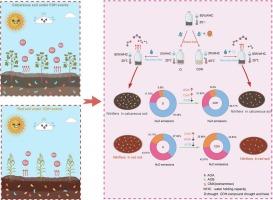复合干热遗产促进了共莫菌硝化螺旋菌对N2O排放的贡献:酸性和碱性土壤都证明了这一点
IF 6.6
1区 农林科学
Q1 SOIL SCIENCE
引用次数: 0
摘要
完全氨氧化(comammox)对复合干旱和高温的响应及其对干旱后氧化亚氮(N2O)排放的贡献尚不清楚。通过选择性抑制和qPCR定量分析,对酸性红土和碱性钙质土壤中氨氧化古菌(AOA)、细菌(AOB)和comammox Nitrospira的N2O产量进行了划分:对照(CK):持水量60% (WHC),温度25°C;(ii)干旱(D): 3% WHC, 25°C;(iii)干热复合胁迫:3% WHC, 45°C。在28 d的复湿阶段,科莫司硝基螺旋菌的回收率高于AOA和AOB。红壤中AOA占N2O排放的主导地位,CK占34.41%,D占43.91%,CDH占42.97%。在钙质土壤中,AOB主导N2O排放,CK占81.78%,D占76.46%,CDH占69.77%。与对照相比,D胁迫使红壤和钙质土壤comcomnox驱动的N2O贡献分别增加10.43%和1.67%,CDH胁迫使红壤和钙质土壤comcomnox驱动的N2O贡献分别增加18.24%和4.27%。这些结果强调了comammox硝化螺旋菌在干旱后硝化作用中是关键的和不可忽视的调节剂,特别是当高温和干旱条件同时发生时。本文章由计算机程序翻译,如有差异,请以英文原文为准。

Compound drought-heat legacies promote the contribution of comammox Nitrospira to N2O emissions: as evidenced from both acidic and alkaline soils
The responses of complete ammonia oxidization (comammox) to compound drought and heat and their contributions to post-drought nitrous oxide (N2O) emissions remain unclear. Through selective inhibition coupled with qPCR quantification, we partitioned N2O production from ammonia-oxidizing archaea (AOA), bacteria (AOB), and comammox Nitrospira in acidic red and alkaline calcareous soils under three treatments: (i) control (CK): 60 % water holding capacity (WHC), 25 °C; (ii) drought (D): 3 % WHC, 25 °C; and (iii) compound drought and heat (CDH) stress: 3 % WHC, 45 °C. Comammox Nitrospira exhibited faster recovery rates than AOA and AOB during the 28-day rewetting phase. AOA dominated N2O emissions in red soil, contributing 34.41 % in CK, 43.91 % in D, and 42.97 % in CDH. AOB dominated N2O emissions in calcareous soil, accounting for 81.78 % in CK, 76.46 % in D, and 69.77 % in CDH. D stress elevated comammox-driven N2O contributions by 10.43 % in red soil and 1.67 % in calcareous soil compared with CK, while CDH stress increased them by 18.24 % and 4.27 % in these soils, respectively. These results highlight comammox Nitrospira as pivotal and non-negligible regulators in post-drought nitrification, particularly when heat and drought conditions coincide.
求助全文
通过发布文献求助,成功后即可免费获取论文全文。
去求助
来源期刊

Geoderma
农林科学-土壤科学
CiteScore
11.80
自引率
6.60%
发文量
597
审稿时长
58 days
期刊介绍:
Geoderma - the global journal of soil science - welcomes authors, readers and soil research from all parts of the world, encourages worldwide soil studies, and embraces all aspects of soil science and its associated pedagogy. The journal particularly welcomes interdisciplinary work focusing on dynamic soil processes and functions across space and time.
 求助内容:
求助内容: 应助结果提醒方式:
应助结果提醒方式:


